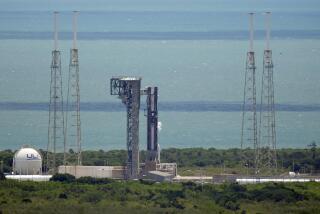Shuttle Weathers Excessive Wind Gusts at Liftoff
- Share via
KENNEDY SPACE CENTER, Fla. — The shuttle Columbia roared safely into space with six astronauts and a laser-reflecting satellite Thursday after NASA officials waived a flight rule despite excessive wind gusts.
“The flagship of the fleet is back in space again,” shuttle Commander James Wetherbee said moments after the National Aeronautics and Space Administration’s oldest shuttle reached orbit.
High crosswinds at Kennedy Space Center’s emergency landing strip delayed liftoff for nearly two hours. NASA officials pressed forward with the launching even though gusts exceeded the allowable limit of 17 m.p.h. by 7 m.p.h.
Shuttle deputy director Brewster Shaw said he and other mission managers decided to launch Columbia because the average speed of the wind was within limits.
Shaw, a former shuttle commander, said that if Columbia had had to return to Kennedy because of main engine failure, the landing would have been safe despite the wind. The gusts occurred about every minute and lasted up to seven seconds, he said.
Columbia’s 10-day mission is the 51st shuttle flight and the 26th since Challenger exploded in 1986.
Once settled in orbit, the crew of five Americans and one Canadian prepared for their first major task--release of the Laser Geodynamics Satellite, or LAGEOS. Geologists hope to track the slow drifting of continents by firing laser beams at the satellite and measuring the time it takes for the pulses to be reflected to Earth.
The aluminum and brass ball, just two feet in diameter but weighing 900 pounds, was to be freed from the cargo bay this morning. The satellite is studded with 426 prisms, giving it the appearance of a golf ball.
LAGEOS is identical to a satellite launched by NASA on an unmanned rocket in 1976. It is expected to provide more accurate information on the movement of Earth’s crustal plates and, as a result, improve scientists’ understanding of earthquakes.
After deploying LAGEOS, the astronauts will perform medical, metal-melting and ozone experiments, keep tabs on 12 rats flying as a part of a bone loss study and test a Canadian robotic vision system designed for the shuttle arm. The vision system is expected to improve the precision with which astronauts can use the crane to lift objects and, eventually, build space station Freedom.
The 51st Shuttle Mission
Here is some background on the Columbia mission, which began Thursday:
Duration: 10 days
Crew: Six, including Commander James Wetherbee, Americans Michael Baker, Tamara Jernigan, William Shepherd and Charles Lacy Veach, and Canadian laser physicist Steven MacLean.
Main mission: Release of a giant, laser-reflecting ball that geologists will use to track Earth’s creeping crust and learn more about earthquakes.
Special concerns: Columbia’s cargo hold is far from full and some scientists have questioned using a manned space shuttle to deploy the satellite. They say an unmanned rocket would be far less expensive and pose no risk to astronauts.
Source: Times wire services
More to Read
Sign up for Essential California
The most important California stories and recommendations in your inbox every morning.
You may occasionally receive promotional content from the Los Angeles Times.













